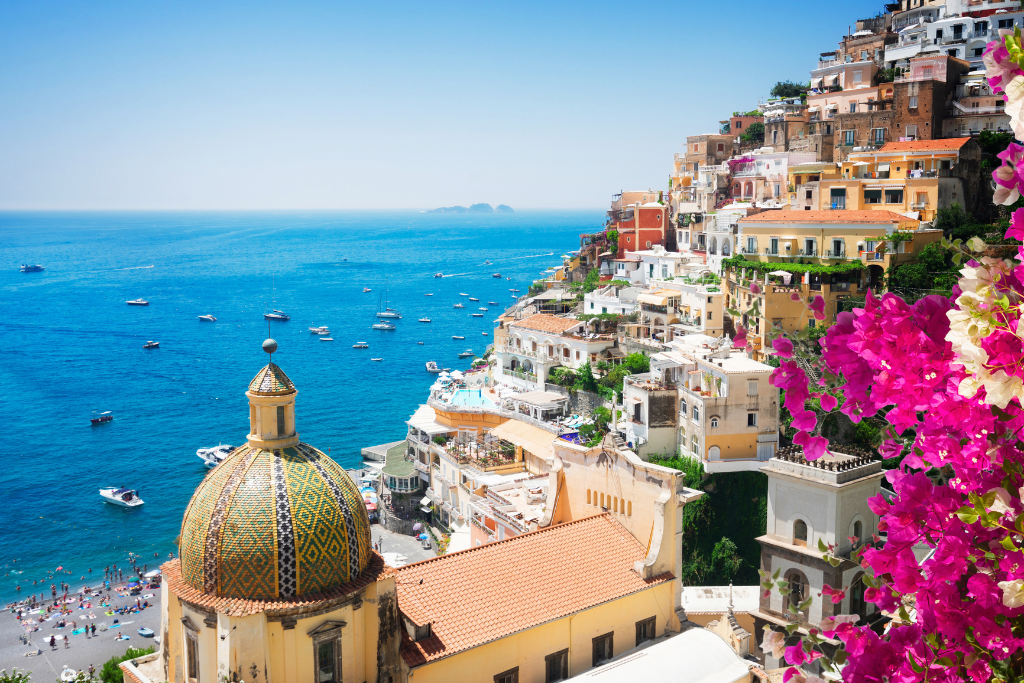Known for its delicious food, wine, art and fashion, Italy has a lot to offer Canadians who are looking to settle down elsewhere. Before moving to Italy, there are several things you need to prepare. Here are the 7 things you need to know and do before moving from Canada to Italy.
Important things to know before moving from Canada to Italy
What to know before your move from Canada to Italy
1. First steps before moving to Italy
Visa requirements
If you’re moving to Italy for work, school, or to join your spouse, the process will be quite easy. There are many types of visas that allow you to move to Italy from Canada, here are the most popular one’s. To find the correct visa for your situation, you can use Italy’s very easy to use visa section on their immigration website.
Work Visa
The first step to applying for a work visa in Italy is to complete the visa entry request form. You must also have a valid passport and have received approval from the SUI (Sportello Unico per l’Immigrazione). You can begin your visa application process at your nearest Italian Consulate or Embassy. You can find your nearest one after completing this short form. The Consulate you will have to visit may vary based on your employment situation.
Joining Family Visa
To begin your visa application to join family in Italy, you must complete the visa entry application form. You must also hold a valid passport and have received authorization from the SUI (Sportello Unico per l’Immigrazione). To start your application, visit your nearest Italian Embassy or Consulate. To find your nearest one, complete this short form and see the locations you can visit based on your situation.
Study Visa
To study in Italy, you must first fill the visa entry application form. You must have a valid passport, proof of accommodation, proof of sufficient funds, private health insurance and proof of acceptance in an Italian educational institution.
To study in Italy you will also need approval from the SUI (Sportello Unico per l’Immigrazione). To begin the visa application process, find your closest Consulate or Embassy by filling out this short form.
Canada-Italy Youth Mobility Agreement
The Canada-Italy Youth Mobility Agreement allows youth between the ages of 18 and 35 to study or work temporarily in Italy. This is a great way to travel while also being productive. To begin your adventure in Italy and for more information on the Youth Mobility Agreement, click here.
Finding a job
Italy offers a laid-back lifestyle and year-round good weather. While it may not be renowned for abundant job opportunities like Canada, there are still diverse employment options available. Although salaries might be slightly lower, the cost of living is more affordable, ensuring a comfortable life.
In-demand jobs for expats in Italy encompass roles such as business consultants, doctors, engineers, English teachers, and programmers.
Getting there
Hiring an international moving company
Shipping your things to Italy by plane will be faster but a lot costlier than by boat. Make sure the moving company you decide on is reliable. So when opting for an international moving company, here’s what you should look for:
- Insurance is included (ask what’s included)
- Rates are not extravagant (compare with other companies)
- They have many Google reviews that are over 4 stars.
- Customer service and transparency is their priority.
Car Shipping to Italy
Unless they have significant emotional attachment to their car, most Canadians choose to leave their cars behind when moving to Italy due to the elevated shipping and import fees and the long vehicle inspection process. If you must absolutely ship your car to Italy, here are the steps to follow:
- Get various quotes from the best car shipping companies. A trusted car shipping company will have insurance, good reviews, and will make customer service their priority.
- Choose the port of departure.
- Choose the port destination.
- Prepare the car by cleaning it and emptying the tank to ⅛ full or you may have to pay a fee upon arrival.
*Ask your chosen car shipping company for additional requirements.
Must dos before your arrival
Moving from Canada to Italy can be both exciting and challenging. Being aware of these things beforehand will better prepare you for your new life:
- Learn the language. While less than half of the Italian population speaks English, there are no legal requirements for needing to speak Italian when moving to Italy. However, speaking Italian when moving to Italy is very useful as it will help you engage more with the locals and feel more at home.
- Prepare for the right currency. Italy uses the Euro as its currency, with notes in denominations of €500, €200, €100, €50, €20, €10, and €5, along with coins in €2, €1, 50c, 20c, 10c, 5c, 2c, and 1c. You can obtain Euros from ATMs, but it’s advisable to carry cash as not all places in Italy accept cards. The Lira ceased to be a legal currency more than 10 years ago, with Italian banks discontinuing its acceptance in 2011.
- Get private health insurance. For your first year of residency in Italy, you will need to purchase private health insurance as you won’t have access to free healthcare. Some great health insurance options are Allianz, Now Health, and Pacific Prime.
2. Upon your arrival in Italy
Must dos right upon your arrival
- Apply for the Permit of stay (permesso di soggiorno). Bring your entry visa that you had received prior to your arrival in Italy to your local post office (Poste Italiane) so you can get a form to apply for a Permit of Stay (Permesso di Soggiorno). After filling the form, you can send it to the local police station or bring it yourself. Bring cash as they may not accept bank cards. The permit of stay is required for anyone who wants to stay in Italy for over 3 months.
- Apply for Residency. 20 days after the reception of your Permit of Stay, you must visit the Vital Statistics Bureau (Ufficio di Stato Civile) to apply for residency. This process may take a few months so make sure to keep the receipt they give you so you can use it to apply for other important things like opening a bank account.
- Get your Italian Tax Code. This code will allow you to open a bank account, rent an apartment, and many other types of registrations. To get your Tax Code, visit your local Tax Office (Agenzia delle Entrate).
Healthcare
Ranked as one of the top healthcare systems in Europe, healthcare in Italy is public and free for all its legal residents and citizens. After one year of residency in Italy, you will automatically be eligible for free healthcare, prior to that you must have private health insurance (see section below).
The schedule of family doctors is a bit complex. Some days are reserved for walk-ins and some days are only by appointment. Most doctor’s don’t speak English, so it is wise to know basic Italian before a doctor’s visit.
Setting up your cell phone
To get an Italian cell phone on a contract or with a SIM card, you will need your Italian Tax Number. The top cell phone providers in Italy are TIM, Vodafone and Wind. A cell phone plan will cost an average of $60-$70 CAD per month for unlimited calling and texting with 5 Gb of data.
Getting a driver’s license
You can drive with your valid Canadian driver’s license for up to a year after your move to Italy. After one year, you will have to undergo a mandatory practical and theory driving test. To begin your license exchange process, visit your local Agency of Ministry of Transport (Ufficio della Motorizzazione Civile) by choosing your province here.
Setting up a bank account
Opening a resident bank account in Italy is advisable for long-term stays due to lower interest charges. It’s recommended to apply in person since you’re new to Italy. You’ll need your Passport, Tax Code, proof of address, and possibly work or enrollment documents if you’re a student or worker. Common Italian banks include Unicredit, Banca Nazionale del Lavoro, and Deutsche Banks Italia.
3. Best places to live in Italy

Italy is home to numerous stunning and distinctive cities and villages, each with its own charm and perfectly made for you to settle. Your personal preferences, way of life, and financial situation will all influence where you should live in Italy.
- Rome is self-explanatory, offering a high standard of living and numerous foreign schools.
- Milan, the financial and fashion hub of Italy, draws business and creative professionals with its fast-paced lifestyle and vibrant nightlife.
- Umbria, lesser-known but cost-effective, offers an authentic rural Italian experience for those seeking peace and simplicity.
Setting up home services
When moving to a new home or apartment in Italy, the first step is to check if the electricity or gas meters are active. If the meters are present but not active, you must get in touch with your local provider. You can find your local electricity or gas provider by entering your region or postal code here.
Unlike Canada where water is unlimited, Italy limits the amount of water you can use per year. This said, you will have a certain limit of water you can use over the year. To get connected to water in Italy, contact your local comune office (Ufficio Acquedotto).
Should you rent or buy?
Houses and apartments for rent or for sale in Italy can be found on websites like Idealista, Casa.it and Casevacanza.it. Housing and renting pricing is higher in cities like Milan, Florence and Rome.
A lot of Canadians choose to live further away from the city in which you can find beautiful places for rent as low as 300 euros/month (450 CAD). One of these beautiful and affordable places is the region of Abruzzo (see cost of living below).
4. Cost of living in Italy
| Category | Monthly cost |
| 1 bed apt rent outside city center | €568.34 |
| GroceriesThe Numbeo grocery list (excluding beer and cigarettes)
was totaled and multiplied by seven for a 2000-calorie diet. |
€499.45 |
| UtilitiesElectricity, heating, cooling, water, garbage | €196.51 |
| Internet with 60 Mbps | €27.34 |
| Transit pass | €36.00 |
| EntertainmentMeal, taxi, movie | €71.50 |
| Gym membership | €48.70 |
| Total | €1,447.84 |
What to expect from your new life in Italy
In Italy you can expect good food and beautiful views. You will see pasta on the menu at every restaurant and all your meals with new friends will start with an aperitivo (pre-dinner drink).
If you plan to live in the city, you should check out the countryside from time to time to get a look at those breathtaking views. Want to know more about moving from Canada to Europe? Check out our article on the Things to Know before Moving from Canada to Europe.
When in the fruits and vegetable section of an Italian grocery store, use gloves and bag your produce. Weigh your items on a scale for a weight sticker. Bring your own bags as plastic bags are banned. Ask workers before handling produce at outdoor stands. In larger stores, insert a 1 euro coin for a basket, refundable upon return. Major grocery chains in Italy include Coop, CRAI, Esselunga, Pam, Standa, Carrefour, and Auchan.
5. The weather in Italy
Despite being small, Scottish weather is unexpected compared to Canada.
- Spring – during the months of March, April, and May, average maximum temperatures will vary from 10°C to 21°C.
- Summer – the hottest months of Italy are typically June, July, and August, with average maximum temperatures ranging from 28°C to 32°C.
- Autumn – from September through November, temperatures in Italy are expected to range from roughly 18°C to 22°C.
- Winter – the coldest months in Italy are typically December, January, and February, with average maximum temperatures hovering between -3°C to 12°C .
6. What to do as a local in Italy
- Italians love outdoor activities, so you can see them taking part in outdoor activities such as hiking, skiing, cycling, or swimming.
- Italians are known as food lovers; during their free time, they visit their local cuisine and discover hidden gems, such as family-run trattorias or street food stalls.
- Italy is known for its bustling open-air markets, where you can find fresh produce, clothing, crafts, and other goods. You can see locals sitting in the market with their families during their free time.
7. Fun facts about Italy
- There are ancient public drinking fountains scattered everywhere that locals still use.
- Rome has more than 900 churches.
- Europe’s oldest university, University of Bologna, is located in Italy.
Conclusion
Moving from Canada to Italy can be an exciting adventure, but it’s important to be prepared for some cultural adjustments. You may enjoy your time in this beautiful country to the fullest if you have an open mind and are prepared to try new things. After reading MovingWaldo’s guide to moving from Canada to Italy, we hope you will have a better idea of what to expect and be in a better position to make your decision.





